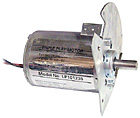


Fig. 7.1: GS Exercise Motor
To go variable speed DC, the first thing I needed was a suitable motor. Somewhere along the line I had picked up one of those GS Electric Triple Play exercise motors that are so common on the web. It was just sitting on the shelf because I’d never got a controller for it. Now I wondered if it would be a good choice for a DC drive. General Signal was bought by SPX Corp. in 1998 and there was no longer any information on this motor from the manufacturer. To get some idea about its suitability , I turned to Sherline whose lathe is about the same size and capacity as the Taig.
At first glance, Sherline’s motor specifications at 90 volts and 6100 rpm seem pretty similar to the GS. But the horsepowers are quite different. Sherline states theirs as .06 KW (60 W) at 10 oz. in. at 6100 rpm which is only around 1/12th horsepower. The GS is 1/4 HP at 6000 rpm, about 3 times greater.
The Sherline spindle speed range is 70 - 2800 rpm which looks as if they must run the motor down to less than 5% of full speed, and get useful work out of the resulting .004 or so horsepower. If that works for them, the GS motor should work great for me on the Taig.
The next requirement was a good DC controller. I wanted one small enough to integrate with the motor so the combined unit could be mounted right on the headstock. I also wanted to be able to stop and start the motor without changing the speed regulator. Many controllers make you turn the speed all the way down before you can start the motor. Often, though, you just want to stop and take a micrometer measurement or brush away swarf. In that case, it’s a real nuisance having to turn down, turn off, do whatever, turn on and turn up groping for the speed you had before. So I went looking and turned up the Dart Controls model 125D shown in Fig. 7.2. This is a small industrial grade analog type SCR drive that satisfies all my wants. It fits nicely in a Hammond 1444-8 aluminum box which can be mated to the motor with the mounting plate as shown in Fig. 7.3.
Unfortunately, I didn’t make any record of exactly how this system behaved and can only describe it to the best of my recollection. I used it with both the Taig pulley set and the 5M pulley set left over from the belt adventure. The 5M’s were two-step with diameters of 26mm (1 1/16”) and 50mm (2”) so they couldn’t slow the spindle as much as the highest Taig ratio. But they could handle a lot more power. Figures 7.4 and 7.5 show how these two systems looked when mounted on the lathe. I used an aluminum mounting block attached to the headstock almost exactly mirroring the one Taig uses on the manual mill.
Here are my observations:
This was a pretty decent system. John Bentley uses one to this day and you can’t get a higher recommendation than that. But this experimentation was becoming almost a hobby in itself and I wanted to see just how much more improvement might be possible. Read on.